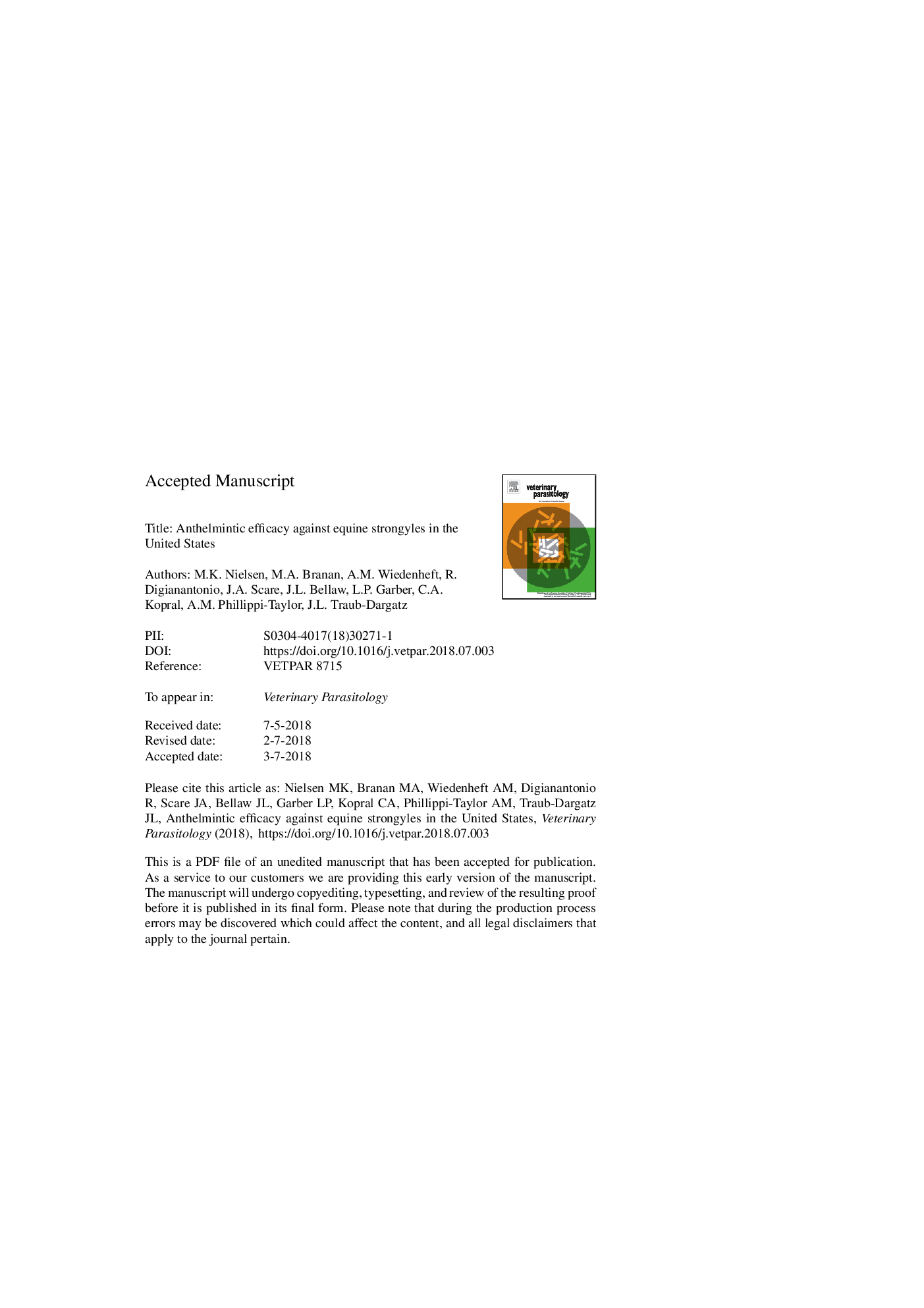| کد مقاله | کد نشریه | سال انتشار | مقاله انگلیسی | نسخه تمام متن |
|---|---|---|---|---|
| 8505883 | 1555617 | 2018 | 33 صفحه PDF | دانلود رایگان |
عنوان انگلیسی مقاله ISI
Anthelmintic efficacy against equine strongyles in the United States
ترجمه فارسی عنوان
اثربخشی آنتیگلمینتیک در برابر اسبها در ایالات متحده آمریکا
دانلود مقاله + سفارش ترجمه
دانلود مقاله ISI انگلیسی
رایگان برای ایرانیان
موضوعات مرتبط
علوم زیستی و بیوفناوری
علوم کشاورزی و بیولوژیک
علوم دامی و جانورشناسی
چکیده انگلیسی
Equine strongyle parasites are ubiquitous in grazing equids across the world. Anthelmintic resistance is widely developed in cyathostomin populations, but very few surveys have evaluated anthelmintic efficacy in equine populations in the United States, and most of these are over 15 years old. The present study was carried out as part of the National Animal Health Monitoring Systems (NAHMS) Equine 2015-2016 study. The aims were to investigate anthelmintic treatment efficacy by means of the fecal egg count reduction test (FECRT) and identify parameters associated with decreased efficacy. Data were collected from equine operations in 28 states via questionnaires and fecal samples submitted for fecal egg count analysis. Participants were instructed to collect samples from six equids at the day of anthelmintic treatments and 14 days later, and they were asked to include an empty syringe with a legible label of the anthelmintic product used in the shipment. Overall, dewormer treatment was effective for 76.3% of operations (84.6% of animals). Macrocyclic lactone use was effective for 88.7% of operations (95.0% of animals) while pyrimidine/benzimidazole use was effective for 21.4% of operations (43.5% of animals). Univariate analysis revealed that overall, macrocyclic lactones exhibited significantly higher efficacy than the pyrimidine and benzimidazole drug classes (pâ¯<â¯0.0001). There were no statistically significant differences observed between geographic regions (West, South Central, North East, and Southeast). Body weight (pâ¯=â¯0.0355), amount of anthelmintic administered (pâ¯=â¯0.0119), and operation size (pâ¯=â¯0.0162) were statistically associated with anthelmintic efficacy, while anthelmintic treatment frequency in the previous 12 months was not (pâ¯=â¯0.7081). Multiple, mixed-effect logistic regression revealed that anthelmintic drug class (pâ¯<â¯0.0001) was the most impactful factor in predicting anthelmintic efficacy, after accounting for operation size, region and clustering of equids at the operation level. Pasture rotation (pâ¯=â¯0.0129) also demonstrated a significant effect using this model. These data document widespread occurrence of reduced anthelmintic efficacy of benzimidazole and pyrimidine products against strongyle infections in equids in the United States. Anthelmintic efficacy patterns were relatively uniform between the four studied regions, and some epidemiological factors were identified to be associated with anthelmintic efficacy against strongyle infections. This information can be useful in devising sustainable parasite control strategies in the future.
ناشر
Database: Elsevier - ScienceDirect (ساینس دایرکت)
Journal: Veterinary Parasitology - Volume 259, 15 August 2018, Pages 53-60
Journal: Veterinary Parasitology - Volume 259, 15 August 2018, Pages 53-60
نویسندگان
M.K. Nielsen, M.A. Branan, A.M. Wiedenheft, R. Digianantonio, J.A. Scare, J.L. Bellaw, L.P. Garber, C.A. Kopral, A.M. Phillippi-Taylor, J.L. Traub-Dargatz,
